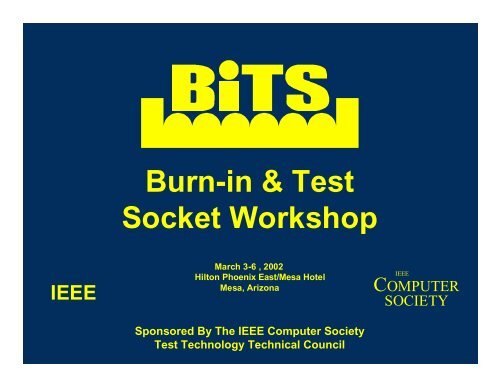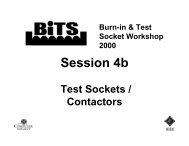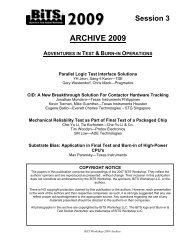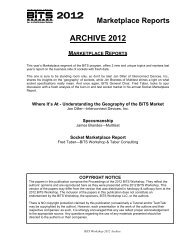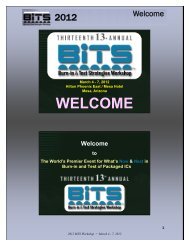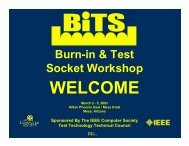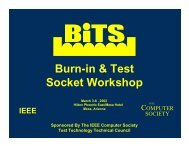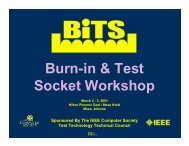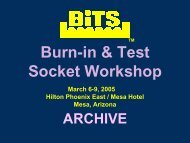Burn-in & Test Socket Workshop - BiTS Workshop
Burn-in & Test Socket Workshop - BiTS Workshop
Burn-in & Test Socket Workshop - BiTS Workshop
You also want an ePaper? Increase the reach of your titles
YUMPU automatically turns print PDFs into web optimized ePapers that Google loves.
<strong>Burn</strong>-<strong>in</strong> & <strong>Test</strong><br />
<strong>Socket</strong> <strong>Workshop</strong><br />
IEEE<br />
March 3-6 , 2002<br />
Hilton Phoenix East/Mesa Hotel<br />
Mesa, Arizona<br />
IEEE<br />
COMPUTER<br />
SOCIETY<br />
Sponsored By The IEEE Computer Society<br />
<strong>Test</strong> Technology Technical Council
COPYRIGHT NOTICE<br />
• The papers <strong>in</strong> this publication comprise the proceed<strong>in</strong>gs of the 2002<br />
<strong>BiTS</strong> <strong>Workshop</strong>. They reflect the authors’ op<strong>in</strong>ions and are reproduced as<br />
presented , without change. Their <strong>in</strong>clusion <strong>in</strong> this publication does not<br />
constitute an endorsement by the <strong>BiTS</strong> <strong>Workshop</strong>, the sponsors, or the<br />
Institute of Electrical and Electronic Eng<strong>in</strong>eers, Inc.<br />
· There is NO copyright protection claimed by this publication. However,<br />
each presentation is the work of the authors and their respective<br />
companies: as such, proper acknowledgement should be made to the<br />
appropriate source. Any questions regard<strong>in</strong>g the use of any materials<br />
presented should be directed to the author/s or their companies.
<strong>Burn</strong>-<strong>in</strong> & <strong>Test</strong> <strong>Socket</strong><br />
<strong>Workshop</strong><br />
Technical Program<br />
Session 2<br />
Monday 3/04/02 10:30AM<br />
Manag<strong>in</strong>g High Frequency Requirements<br />
“Optimiz<strong>in</strong>g Load Board Design And Model<strong>in</strong>g For High Frequency<br />
Contactors”<br />
Jeff Sherry - Johnstech International Corporation<br />
“The New YieldPro Array Series Contactor”<br />
Julius Botka - Agilent Technologies<br />
“Electrical And Mechanical Performance Characterization Of High Frequency<br />
<strong>Test</strong> <strong>Socket</strong>s”<br />
Lisa Steckley - IBM Microelectronics<br />
Dr. Hanyi D<strong>in</strong>g - IBM Microelectronics
Optimiz<strong>in</strong>g Load Board<br />
Design and Model<strong>in</strong>g<br />
for<br />
High Frequency<br />
Contactors<br />
Jeff Sherry, RF Eng<strong>in</strong>eer<br />
Johnstech International<br />
1
Discussion Topics<br />
▼ Model<strong>in</strong>g & its importance<br />
▼ Design<strong>in</strong>g load boards for optimal<br />
performance<br />
▼ Load board effects<br />
▼ Ground<strong>in</strong>g schemes<br />
▼ Crosstalk improvements<br />
▼ Load board pad size and placement<br />
▼ Model validation & performance examples<br />
2
Model<strong>in</strong>g & Its Importance<br />
▼ Determ<strong>in</strong>e potential problems before<br />
build<strong>in</strong>g hardware<br />
▼ Determ<strong>in</strong>e expected performance<br />
▼ Determ<strong>in</strong>e trends and sensitivity of circuits<br />
▼ Determ<strong>in</strong>e effects of tolerances<br />
▼ Determ<strong>in</strong>e <strong>in</strong>teraction between components<br />
<strong>in</strong> system (device, contactor, handler, etc.)<br />
▼ Design for the device, form, fit, and<br />
function of the end application<br />
3
Design<strong>in</strong>g Load Boards for<br />
Optimal Performance<br />
Microstrip and Coplanar Effects<br />
▼ Substrate thickness ↓ Impedance ↓<br />
▼ Trace width ↓ Impedance ↑<br />
▼ Permittivity (ε<br />
(ε r ) ↓ Impedance ↑<br />
▼ Trace thickness ↓ Impedance ↑<br />
Coplanar Waveguide Effects<br />
▼ Spac<strong>in</strong>g (pitch) ↓ Impedance ↓<br />
▼ Add<strong>in</strong>g ground plane Impedance ↓<br />
4
Load Board Effects<br />
▼ Loss tangent affects <strong>in</strong>sertion loss more at higher<br />
frequencies<br />
▼ Uniformity of ε r and loss tangent vs. frequency<br />
▼ Substrate thickness affects <strong>in</strong>ductance to ground<br />
▼ Increased frequency means th<strong>in</strong>ner substrates<br />
▼ Substrate thickness and dielectric constant (ε r ),<br />
along with l<strong>in</strong>e width, are major parameters <strong>in</strong><br />
controll<strong>in</strong>g impedance<br />
▼ Plat<strong>in</strong>g thickness has the biggest effect on load<br />
board life<br />
5
Load Board Effects<br />
▼ Th<strong>in</strong>gs to improve load board design<br />
▼ Elim<strong>in</strong>ate right angles<br />
▼ Elim<strong>in</strong>ate changes <strong>in</strong> l<strong>in</strong>e width<br />
▼ Separate high frequency traces with ground<br />
▼ Move clock traces away from other signal<br />
l<strong>in</strong>es<br />
▼ Place decoupl<strong>in</strong>g components close to the<br />
device<br />
▼ Use matched impedance traces up to the<br />
device or test contactor<br />
6
Ground<strong>in</strong>g Schemes<br />
▼ Length and area of the ground path is very<br />
important<br />
▼ Ground <strong>in</strong>ductance should be m<strong>in</strong>imized<br />
▼ Resistance of ground should be low (to<br />
m<strong>in</strong>imize power supply voltage drop)<br />
▼ Ground<strong>in</strong>g controls crosstalk between signals<br />
7
Crosstalk Improvements<br />
▼ Increase the spac<strong>in</strong>g (S) between traces<br />
▼ M<strong>in</strong>imize substrate height (H) while achiev<strong>in</strong>g<br />
matched impedance<br />
▼ Route signals orthogonally between layers<br />
▼ M<strong>in</strong>imize parallel run<br />
lengths between signals<br />
▼ Use differential rout<strong>in</strong>g<br />
for clock or critical nets<br />
8
Load Board Pad Size and<br />
Placement<br />
9
Load Board Pad Size and<br />
Placement<br />
10
Model Validation &<br />
Performance Examples<br />
▼ Validat<strong>in</strong>g the Model<br />
▼ Expla<strong>in</strong> test results<br />
▼ Confirm if contactor will meet customer needs<br />
▼ Identify improvements to contactor<br />
▼ Identify improvements to load board (i.e. pad<br />
sizes)<br />
▼ Determ<strong>in</strong>e equivalent circuits<br />
▼ Investigate changes to contactors to meet<br />
customer specific needs<br />
11
Return Loss (dB)<br />
0<br />
-5<br />
-10<br />
-15<br />
-20<br />
-25<br />
-30<br />
-35<br />
-40<br />
-45<br />
-50<br />
Model Validation &<br />
Performance Examples<br />
Leaded Series Return Loss (S 11 ) Data<br />
Measured <strong>Test</strong> Data Taken by Giga<strong>Test</strong> Labs for<br />
.010" Thick Contact<br />
Equivalent Circuit Modeled Data for .010" Thick<br />
Contact<br />
Optimum Load Board Layout Match Us<strong>in</strong>g HFSS<br />
-20 dB Po<strong>in</strong>t 10.6 GHz from Measured Data<br />
0 1 2 3 4 5 6 7 8 9 10<br />
Frequency (GHz)<br />
12
0<br />
-0.25<br />
Model Validation &<br />
Performance Examples<br />
Leaded Series Insertion Loss (S 21 ) Data<br />
Insertion Loss (dB)<br />
-0.5<br />
-0.75<br />
-1<br />
-1.25<br />
-1.5<br />
Measured <strong>Test</strong> Data Taken by Giga<strong>Test</strong> Labs for<br />
.010" Thick Contact<br />
Equivalent Circuit Modeled Data for .010" Thick<br />
Contact<br />
Optimum Load Board Layout Match Us<strong>in</strong>g HFSS<br />
-1.75<br />
-2<br />
0 1 2 3 4 5 6 7 8 9 10<br />
Frequency (GHz)<br />
13
Model Validation &<br />
Performance Examples<br />
10GBit/s BGA Non-Optimized Load Board Layout<br />
14
Model Validation &<br />
Performance Examples<br />
10GBit/s BGA Optimized Load Board Layout<br />
15
Model Validation &<br />
Performance Examples<br />
10GBit/s BGA With Non-Optimized Load Board<br />
Layout<br />
16
Model Validation &<br />
Performance Examples<br />
10GBit/s BGA With Optimized Load Board Layout<br />
17
Return Loss (dB)<br />
0<br />
-5<br />
-10<br />
-15<br />
-20<br />
-25<br />
-30<br />
Model Validation &<br />
Performance Examples<br />
Return Loss (S 11 ) of Enhanced Pad Series Contact with<br />
Previous Standard Pad and Optimal Load Board Pad<br />
Previously Standard Pad with Optimum Contact<br />
Optimum Load Board Pad and Contact<br />
-35<br />
-40<br />
1 2 3 4 5 6 7 8 9 10<br />
Frequency (GHz)<br />
18
Model Validation &<br />
Performance Examples<br />
Insertion Loss (S 21 ) of Enhanced Pad Series Contact With<br />
Previous Standard Pad and Optimum Load Board Pad<br />
0<br />
-0.1<br />
-0.2<br />
Insertion Loss (dB)<br />
-0.3<br />
-0.4<br />
-0.5<br />
-0.6<br />
-0.7<br />
-0.8<br />
-0.9<br />
-1<br />
Previously Standard Pad with Optimum Contact<br />
Optimum Load Board Pad and Contact<br />
All data modeled <strong>in</strong> HFSS<br />
-1 dB po<strong>in</strong>t @ 20+ GHz<br />
1 2 3 4 5 6 7 8 9 10<br />
Frequency (GHz)<br />
19
Conclusion<br />
▼ Model<strong>in</strong>g trends can determ<strong>in</strong>e how to<br />
improve load board layout<br />
▼ Load board layout can greatly affect test data<br />
▼ Good microwave design pr<strong>in</strong>ciples apply to<br />
load board design<br />
▼ Model<strong>in</strong>g and test data have shown that<br />
significant improvement can be atta<strong>in</strong>ed by<br />
better match<strong>in</strong>g load board and contactor<br />
impedance to the Device Under <strong>Test</strong> (DUT)<br />
▼ Ball Series contributions from Quake<br />
Technologies <strong>in</strong>dicated with the Quake logo<br />
20
The New YieldPro Array Series Contactor<br />
Patent USP# 6,299,459<br />
Julius Botka, Master Scientist<br />
julius_botka@agilent.com
Brief History<br />
• Semiconductor manufacturers and<br />
test houses are required to test<br />
devices with multiple functions<br />
• Packages vary <strong>in</strong> type, size and pitch<br />
• Contactors provide the f<strong>in</strong>al crucial<br />
l<strong>in</strong>k to testers<br />
• First YieldPro contactor patented <strong>in</strong><br />
1997<br />
• Lowest parasitics with<br />
<strong>in</strong>dependently<br />
compliant wip<strong>in</strong>g contacts<br />
Frame and<br />
Slider<br />
mounted on<br />
elastomer<br />
Frame with<br />
slider<br />
<strong>in</strong>serted<br />
Julius Botka<br />
BITS.ppt 10/31/01<br />
• Path length is 0.037”,<br />
performance up to 18GHz<br />
Simple<br />
SOIC-8<br />
Hous<strong>in</strong>g<br />
Page 2
Orig<strong>in</strong>al YieldPro Contactor for Leaded<br />
Components<br />
Patent USP# 5,609,489<br />
Julius Botka<br />
BITS.ppt 10/31/01<br />
Page 3
Today’s evolution of the<br />
bus<strong>in</strong>ess:<br />
• Size and pitch keep gett<strong>in</strong>g smaller, number of<br />
contacts <strong>in</strong>creas<strong>in</strong>g<br />
• Move from leaded to leadless BGA/LCC packages (Ball<br />
Grid Array and Leadless Chip Carrier)<br />
Leaded YieldPro Contactor<br />
YieldPro Array Contactor<br />
USP#6,299,459<br />
Julius Botka<br />
BITS.ppt 10/31/01<br />
Page 4
The New YieldPro Array Contactor<br />
• A new solution is needed for<br />
contact<strong>in</strong>g new chip scale<br />
packages, such as BGA and<br />
LCC<br />
• Agilent’s new YieldPro Array<br />
design addresses<br />
technologies, Bluetooth®,<br />
Wireless LAN and high<br />
speed digital components<br />
• All are head<strong>in</strong>g toward<br />
higher frequencies and<br />
require good performance <strong>in</strong><br />
high speed digital, and at the<br />
3rd harmonic of the RF<br />
fundamental<br />
Patent USP# 6,299,459<br />
Julius Botka<br />
BITS.ppt 10/31/01<br />
Page 5
Design Considerations<br />
Problem:<br />
Lack of reliable/repeatable contact between tester and<br />
component to be tested<br />
Solution:<br />
Slider<br />
• Two parallel contact<br />
paths from solder<br />
ball/contact pad to DUT<br />
board<br />
• Contacts do not wear the<br />
DUT board<br />
Julius Botka<br />
BITS.ppt 10/31/01<br />
Page 6
Problem:<br />
Unwanted and unmanageable <strong>in</strong>ductive or capacitance<br />
parasitics<br />
Solution:<br />
• Parasitic <strong>in</strong>ductance<br />
and capacitance are<br />
reduced by<br />
controll<strong>in</strong>g<br />
impedance to be<br />
closer to 50Ω<br />
• Parasitics are further<br />
reduced by<br />
m<strong>in</strong>imiz<strong>in</strong>g height of<br />
the contactor<br />
• If <strong>in</strong>creased<br />
impedance is<br />
required, adjacent<br />
ground contacts can<br />
be removed<br />
Julius Botka<br />
BITS.ppt 10/31/01<br />
CSP<br />
SLIDER<br />
BGA<br />
SLIDER<br />
Page 7
Problem:<br />
Excessive and<br />
undef<strong>in</strong>ed contact<br />
resistance sensitive to<br />
contam<strong>in</strong>ants<br />
Top View<br />
Contact at one<br />
po<strong>in</strong>t/l<strong>in</strong>e only or<br />
through the spr<strong>in</strong>g<br />
*<br />
Breakaway<br />
Side View<br />
Initial Agilent Design<br />
Consideration<br />
Solution:<br />
• Resistance is lowered by<br />
hav<strong>in</strong>g two parallel<br />
contact paths<br />
• The slider can follow the<br />
ball, always ma<strong>in</strong>ta<strong>in</strong><strong>in</strong>g<br />
two contacts to pad or<br />
the sides of the ball<br />
Julius Botka<br />
BITS.ppt 10/31/01<br />
Page 8
Problem:<br />
No wip<strong>in</strong>g contact to ball/pad<br />
Solution:<br />
• Slider wipes the sides of<br />
the ball, while barbs<br />
pierce through the oxide<br />
layer without goug<strong>in</strong>g<br />
either the ball or the pad<br />
• CSP Head contacts flex<br />
and wipe contact pad<br />
toward each other<br />
Flexible<br />
heads<br />
provide<br />
wip<strong>in</strong>g<br />
action<br />
Slider wipes the<br />
sides of the ball,<br />
barbs pierce the<br />
oxide layer<br />
Julius Botka<br />
BITS.ppt 10/31/01<br />
Page 9
Problem:<br />
Damage to the bottom of the solder ball/pad due to<br />
direct hit and excessive pressure from contact<br />
Solution:<br />
• No sharp po<strong>in</strong>ts<br />
associated with the top<br />
of the contact.<br />
Therefore, no goug<strong>in</strong>g<br />
or re-shap<strong>in</strong>g can<br />
occur. The ball/pad is<br />
not damaged by the<br />
YieldPro Array<br />
contactor.<br />
Julius Botka<br />
BITS.ppt 10/31/01<br />
Page 10
Problem:<br />
Given there is always contam<strong>in</strong>ation <strong>in</strong> a test operation,<br />
it becomes very difficult to clean the contactor due to<br />
narrow open spaces on the top surface where<br />
contam<strong>in</strong>ation can lodge<br />
Solution:<br />
• Hous<strong>in</strong>g designed for easy<br />
removal of contam<strong>in</strong>ates<br />
us<strong>in</strong>g low pressure<br />
compressed air<br />
• Complete contactor can be<br />
thoroughly cleaned<br />
ultrasonically<br />
Large gaps<br />
<strong>in</strong> between<br />
contacts<br />
Julius Botka<br />
BITS.ppt 10/31/01<br />
Page 11
Problem:<br />
After 100,000 plunges, excessive wear requires costly and<br />
frustrat<strong>in</strong>g contactor component ma<strong>in</strong>tenance or replacement<br />
Solution:<br />
• New design<br />
supports<br />
operation without<br />
replacement of<br />
parts through<br />
hundreds of<br />
thousands of<br />
cycles<br />
Julius Botka<br />
BITS.ppt 10/31/01<br />
LCC Contact<br />
One of two wipe and<br />
pierce contacts to ball<br />
Slider<br />
Elastomer<br />
Solder ball on bottom of<br />
DUT (Device under <strong>Test</strong>)<br />
Frame<br />
One of two contact<br />
l<strong>in</strong>es to PC Board<br />
pad<br />
Torlon<br />
Hous<strong>in</strong>g<br />
One of two<br />
wip<strong>in</strong>g<br />
contact<br />
<strong>in</strong>teractions<br />
of frame and<br />
slider<br />
Page 12
Problem:<br />
Life of some contactors is limited to a few tens of<br />
thousands plunges, offsett<strong>in</strong>g the <strong>in</strong>itial lower price<br />
Solution:<br />
• Typical life of a new<br />
YieldPro Array<br />
contactor is well over<br />
a million cycles<br />
• Contacts can be<br />
easily replaced on<br />
site<br />
Julius Botka<br />
BITS.ppt 10/31/01<br />
Page 13
Problem:<br />
Plat<strong>in</strong>g will wear away, oxidation may occur<br />
Solution:<br />
• Metal contact<br />
components of the<br />
YieldPro Array<br />
contactors are made<br />
of solid precious and<br />
semi-precious metals<br />
• No <strong>in</strong>crease <strong>in</strong> contact<br />
resistance with wear<br />
Julius Botka<br />
BITS.ppt 10/31/01<br />
Page 14
Problem:<br />
Part handler alignment is difficult.<br />
Solution:<br />
• Generous <strong>in</strong>dividual<br />
<strong>in</strong>dependent contact<br />
compliance, up to<br />
0.011”<br />
• With the contactor<br />
attached to the DUT<br />
board, there is no<br />
force between the<br />
bottom of the<br />
hous<strong>in</strong>g and the<br />
DUT board. This<br />
elim<strong>in</strong>ates hous<strong>in</strong>g<br />
distortion over time<br />
CSP<br />
SLIDER<br />
• Sliders shown <strong>in</strong> fully compressed<br />
position<br />
BGA SLIDER<br />
Julius Botka<br />
BITS.ppt 10/31/01<br />
Page 15
Problem:<br />
Usability issues revolv<strong>in</strong>g<br />
around scaled down versions of<br />
large designs, first developed<br />
for lower frequency applications<br />
Solution:<br />
Initial Agilent design<br />
consideration<br />
Scaled down spr<strong>in</strong>g<br />
uncoils with use, and can<br />
split the hous<strong>in</strong>g sleeve<br />
reta<strong>in</strong><strong>in</strong>g contam<strong>in</strong>ants<br />
and los<strong>in</strong>g compliance<br />
• The YieldPro Array design<br />
concept is not subject to<br />
problems associated with<br />
scaled down designs<br />
• Performs at high RF and<br />
microwave frequencies <strong>in</strong><br />
demand<strong>in</strong>g applications<br />
Julius Botka<br />
BITS.ppt 10/31/01<br />
Page 16
Fixture for Contactor Evaluation<br />
The two oppos<strong>in</strong>g<br />
coplanar waveguide l<strong>in</strong>es<br />
overlap for the length of<br />
the contacts<br />
0.275” wide and 0.010”<br />
thick alum<strong>in</strong>a coplanar<br />
waveguide l<strong>in</strong>e with<br />
0.015” air gap under the<br />
mid 0.230” of width<br />
FR4 support<br />
board<br />
Julius Botka<br />
BITS.ppt 10/31/01<br />
Page 17
Coplanar waveguide substrate with gated short at contactor plane.<br />
Measurement yields 2 x loss and dispersion. (Shift phase 180° before sav<strong>in</strong>g)<br />
Frequency<br />
Doma<strong>in</strong><br />
data<br />
Time<br />
Doma<strong>in</strong><br />
data<br />
Gate<br />
Markers<br />
Julius Botka<br />
BITS.ppt 10/31/01<br />
Page 18
Fixture S-parameters measured<br />
MARKER 1<br />
3 GHz<br />
MARKER 2<br />
6 GHz<br />
MARKER 3<br />
12 GHz<br />
Julius Botka<br />
BITS.ppt 10/31/01<br />
Page 19
Fixture time doma<strong>in</strong> is computed from S-Parameters<br />
Hous<strong>in</strong>g and contacts gated<br />
Gate<br />
Markers<br />
Julius Botka<br />
BITS.ppt 10/31/01<br />
Page 20
S-Parameter of fixture with gates “on”<br />
MARKER 3<br />
(Return Loss)<br />
MARKER 1<br />
3 GHz<br />
MARKER 2<br />
6 GHz<br />
MARKER 3<br />
12 GHz<br />
Julius Botka<br />
BITS.ppt 10/31/01<br />
Page 21
S 11 Gated, coplanar substrate electrical length is<br />
removed with port extension, no loss or dispersion<br />
correction<br />
Port Extension = 348 ps, 104.33 mm, 125.196 degrees<br />
S(1,1)<br />
m3<br />
m2<br />
m1<br />
m1<br />
freq=1.000GHz<br />
S(1,1)=0.041 / -102.526<br />
impedance = Z0 * (0.979 - j0.079)<br />
m2<br />
freq=3.090GHz<br />
S(1,1)=0.110 / -115.386<br />
impedance = Z0 * (0.893 - j0.180)<br />
m3<br />
freq=11.67GHz<br />
S(1,1)=0.073 / -166.014<br />
impedance = Z0 * (0.868 - j0.031)<br />
Scale = 0.25<br />
freq (1.000GHz to 12.00GHz)<br />
Julius Botka<br />
BITS.ppt 10/31/01<br />
Page 22
S 11 gated of contacts and hous<strong>in</strong>g with 2x loss and<br />
dispersion removed by vectorially divid<strong>in</strong>g measured<br />
and gated S 11 by<br />
stored data from Page 18, thereby correct<strong>in</strong>g for loss<br />
and dispersion<br />
Data_m<strong>in</strong>us_loss<br />
m1<br />
m3<br />
m2<br />
m1<br />
freq=1.000GHz<br />
Data_m<strong>in</strong>us_loss=0.044 / -98.862<br />
impedance = Z0 *(0.983 - j0.085)<br />
m2<br />
freq=3.090GHz<br />
Data_m<strong>in</strong>us_loss=0.121 / -104.742<br />
impedance = Z0 *(0.916 - j0.217)<br />
m3<br />
freq=11.78GHz<br />
Data_m<strong>in</strong>us_loss=0.087 / -124.213<br />
impedance = Z0 *(0.898 - j0.130)<br />
freq (1.000GHz to 12.00GHz)<br />
Scale = 0.25<br />
Use this data to<br />
generate model<br />
Julius Botka<br />
BITS.ppt 10/31/01<br />
Page 23
Model of Contacts with Effects of Hous<strong>in</strong>g Overlay<br />
CSP 0.5 mm<br />
TLIN<br />
TL4<br />
Z=48.5497 Ohm opt{ 40 Ohm to 50 Ohm }<br />
E=7.11405 opt{ 6 to 13 }<br />
F=1 GHz<br />
TLIN<br />
TL5<br />
Z=43.0871 Ohm opt{ 40 Ohm to 50 Ohm }<br />
E=9.38041 opt{ 8 to 11 }<br />
F=1 GHz<br />
Term<br />
Term5<br />
Num=5<br />
Z=50 Ohm<br />
TLIN<br />
TL3<br />
Z=50.0 Ohm<br />
E=-9.18889 opt{ -13 to -7.5 }<br />
F=1 GHz<br />
TLIN<br />
TL2<br />
Z=34.5 Ohm opt{ 32 Ohm to 36 Ohm }<br />
E=2.2 noopt{ 1.4 to 2 }<br />
F=1 GHz<br />
Term<br />
Term6<br />
Num=6<br />
Z=50 Ohm<br />
GOAL<br />
Goal<br />
OptimGoal1<br />
Expr="mag(Data_m<strong>in</strong>us_loss-S55)"<br />
SimInstanceName="SP1"<br />
M<strong>in</strong>=<br />
Max=.000001<br />
Weight=<br />
RangeVar[1]=<br />
RangeM<strong>in</strong>[1]=<br />
RangeMax[1]=<br />
OPTIM<br />
Optim<br />
Optim1<br />
OptimType=Gradient<br />
ErrorForm=L2<br />
Ma xIters =25<br />
P=2<br />
DesiredError=0.0<br />
StatusLevel=4<br />
SetBestValues=yes<br />
Seed=<br />
Sa ve Solns=ye s<br />
Sa ve Goa ls=ye s<br />
SaveOptimVars=no<br />
UpdateDataset=yes<br />
SaveAllIterations=no<br />
Us e AllOptVa rs =ye s<br />
Us e AllGoa ls =yes<br />
TL3: Its negative electrical length<br />
resets the phase to zero from<br />
the contacts to the edge of<br />
hous<strong>in</strong>g.<br />
TL4 and TL5: Represent lower<br />
impedance of coplanar<br />
waveguide l<strong>in</strong>es under<br />
hous<strong>in</strong>g to contacts.<br />
TL2: Is the transmission l<strong>in</strong>e<br />
represent<strong>in</strong>g the contacts,<br />
one signal and two grounds<br />
on either side<br />
Julius Botka<br />
BITS.ppt 10/31/01<br />
Page 24
Measured S 11 of gated hous<strong>in</strong>g and contacts<br />
and computed S 11 (S 55 ) from model is shown.<br />
CSP 0.5mm<br />
-14<br />
-16<br />
Data_m<strong>in</strong>us_loss<br />
S(5,5)<br />
Measured Data<br />
Model<br />
dB(Data_m<strong>in</strong>us_loss)<br />
dB(S(5,5))<br />
-18<br />
-20<br />
-22<br />
-24<br />
-26<br />
-28<br />
0 2 4 6 8 10 12<br />
freq, GHz<br />
Scale = 0.2<br />
freq (1.000GHz to 12.00GHz)<br />
Data to 1 GHz and above 12 GHz is discarded due to expected <strong>in</strong>accuracies of time doma<strong>in</strong> conversion.<br />
Good agreement is shown over 3.5 octaves. Evidence of a “good” model!<br />
Julius Botka<br />
BITS.ppt 10/31/01<br />
Page 25
S 11 of contact region from model<br />
CSP 0.5 mm Contactor<br />
Z1 = 34.5 Ohms<br />
Electrical Length @ 10 GHz = 22 degrees<br />
C (distributed over the contact length) = 0.177 pF<br />
L (distributed over the contact length) = 0.211 nH<br />
Max Current = 1A<br />
-10<br />
-15<br />
S11<br />
dB S11<br />
-20<br />
-25<br />
-30<br />
-35<br />
freq (1.000GHz to 18.00GHz)<br />
Scale = 0.25<br />
-40<br />
Use this data to<br />
set specs with<br />
guardband<br />
0 2 4 6 8 10 12 14 16 18<br />
freq, GHz<br />
Julius Botka<br />
BITS.ppt 10/31/01<br />
Page 26
Best DUT Board Practices at High Frequencies<br />
• Coplanar waveguide to contactor is best transmission<br />
type, use on top surface of the board above 6 GHz<br />
• In microstrip, m<strong>in</strong>imize lengths of vias to pads under<br />
contactor<br />
• Use bl<strong>in</strong>d vias, not to have the signal via extend down<br />
to or through the ground plane<br />
• Control impedance between pads under contactor<br />
• Compensate signal path extend<strong>in</strong>g below contactor<br />
hous<strong>in</strong>g, to achieve desired impedance/compensation<br />
for best contactor match<br />
Julius Botka<br />
BITS.ppt 10/31/01<br />
Page 27
Account<strong>in</strong>g for hous<strong>in</strong>g effects<br />
*<br />
*<br />
• This transmission l<strong>in</strong>e represents a reduced impedance segment of the<br />
Zo transmission l<strong>in</strong>e due to the overlay of the hous<strong>in</strong>g from the edge to<br />
the contacts<br />
• A reduction from 50 Ohms to ~ 40 Ohms was seen due to the overlay of<br />
the hous<strong>in</strong>g on a coplanar waveguide transmission l<strong>in</strong>e on the top layer<br />
of the DUT board; Less reduction is expected for microstrip l<strong>in</strong>es<br />
• The effect of the hous<strong>in</strong>g overlay can be mitigated by account<strong>in</strong>g for the<br />
higher effective overall permitivity under the hous<strong>in</strong>g material<br />
• Adjust<strong>in</strong>g the dimensions of the transmission l<strong>in</strong>e accord<strong>in</strong>gly can<br />
ma<strong>in</strong>ta<strong>in</strong> Zo to the contacts<br />
• This same region’s impedance Z2 can be adjusted to values other than<br />
Zo to transform/improve the contact’s specified impedance over the<br />
desired frequency range<br />
Julius Botka<br />
BITS.ppt 10/31/01<br />
Page 28
Values <strong>in</strong> this table perta<strong>in</strong> to center contact with ground contacts on two sides<br />
Contact<br />
Pressure<br />
Contact Width<br />
Recommended<br />
Ball Sizes<br />
Recommended<br />
Size Pad M<strong>in</strong>.<br />
Contact<br />
Compliance<br />
DC Resistance<br />
Leakage<br />
Return Loss<br />
Impedance<br />
Zo<br />
Electrical<br />
Length<br />
Max. Current<br />
Carry<strong>in</strong>g<br />
Capacity<br />
Capacitance<br />
Inductance<br />
Physical<br />
Length<br />
Effective<br />
Dielectric<br />
Constant,<br />
ε eef<br />
Contactor<br />
Type & Pitch<br />
3 GHz 10 GHz 18GHz<br />
Along the<br />
Length of<br />
Contacts<br />
@ 10 GHz<br />
<strong>in</strong> Degrees<br />
Center<br />
Contact to<br />
Ground<br />
For leaded packages/LCC<br />
Note 1 Note 2 Note 3 Note 4 Note 5<br />
Note 6<br />
YieldPro 1.25 mm 40 gr 0.020" 0.007" 12 dB >8 dB 26.3 Ohm 18 3 A 0.190 pF 0.131 nH 0.927 mm / 0.0365" 2.65<br />
Note 7 70 gr max<br />
YieldPro 0.8 mm 25 gr, 0.015" 0.007" 9.5 dB >5.9 dB 22 Ohm 18 2 A 0.227 pF 0.11 nH 0.927 mm / 0.0365" 2.65<br />
Note 7 40 gr max<br />
YieldPro 0.5mm 20 gr, 0.010" 0.007" 7.25 dB >4.5 dB 17.6 Ohm 18 1 A 0.284 pF 0.088 nH 0.927 mm / 0.0365" 2.65<br />
Note7 28 gr max<br />
YieldPro 0.4mm 15 gr, 0.007" 0.007" 9.45 dB >6.15 dB 21 Ohm 18 0.75 A 0.238 pF 0.105 nH 0.927 mm / 0.0365" 2.65<br />
20 gr max<br />
For CSP: BGA/LGA Packages<br />
YieldPro Ultra 30 gr, 0.6-0.762 0.5 x 0.5 0.011" 17.8 dB >14 dB 38.5 Ohm 22 2 A 0.159 pF 0.235 nH 1.438 mm / 0.0566" 1.65<br />
BGA/LGA 1.0mm 50 gr max mm mm<br />
YieldPro Ultra 25 gr, 0.48-0.54 0.35x0.35 0.011" 11.5 dB >8 dB 28.6 Ohm 22 2 A 0.213 pF 0.175 nH 1.438 mm / 0.0566" 1.65<br />
BGA/LGA 0.8mm 40 gr max mm mm<br />
YieldPro Ultra 20 gr, 0.3-0.42 0.2 x 0.2 0.007" 15 dB >11.2 dB 34.5 Ohm 22 1 A 0.177 pF 0.211 nH 1.438 mm / 0.0566" 1.65<br />
BGA/LGA 0.5mm 28 gr max mm mm<br />
Note 1: Resistance measured on a clean contactor.<br />
Note 2: Leakage current measured w ith 10V applied to signal contact.<br />
Note 3: Assumes 50 Ohm environment.<br />
Note 4: Apply current only after mak<strong>in</strong>g contact.<br />
Note 5: Capacitance and Inductance are distributed over the contact length.<br />
Note 6: Physical length is show n fully compressed.<br />
Note 7: Agilent YieldPro contactors for leaded/LCC packages support: SOT, SOIC, SSOP,<br />
TSSOP, MSOP, QFN, TQFP, MLF, and MLP device package requirements.<br />
Julius Botka<br />
BITS.ppt 10/31/01<br />
Page 29
Economic Benefits:<br />
• Increase the yield by not<br />
reject<strong>in</strong>g good parts. Smaller<br />
guard bands can be used<br />
because of less uncerta<strong>in</strong>ty <strong>in</strong><br />
the measurement<br />
• Contacts are made of precious<br />
metal and will not oxidize.<br />
Good performance is<br />
ma<strong>in</strong>ta<strong>in</strong>ed due to lack of<br />
corrosion<br />
• The longer life of the contactor<br />
reduces cost per parts tested<br />
Julius Botka<br />
BITS.ppt 10/31/01<br />
Page 30
Electrical and Mechanical<br />
Performance<br />
Characterization of High<br />
Frequency <strong>Test</strong> <strong>Socket</strong>s<br />
Authors: Dr. Hanyi D<strong>in</strong>g<br />
and Lisa Steckley,<br />
IBM Microelectronics<br />
Presented by: Lisa Steckley
Introduction<br />
This presentation summarizes the ongo<strong>in</strong>g<br />
work at IBM to understand the factors<br />
affect<strong>in</strong>g both the electrical performance and<br />
mechanical durability of several commercial<br />
RF test sockets.<br />
March 3-6, 2002 <strong>BiTS</strong> <strong>Workshop</strong> 2
Objective<br />
Purchase from a s<strong>in</strong>gle source to reduce<br />
COST<br />
Choose best socket for specific application;<br />
PERFORMANCE<br />
Deliver ROBUST manufactur<strong>in</strong>g solution<br />
March 3-6, 2002 <strong>BiTS</strong> <strong>Workshop</strong> 3
<strong>Socket</strong> Requirements for <strong>Test</strong><strong>in</strong>g RF<br />
Modules<br />
High frequency – to 12 GHz<br />
Low <strong>in</strong>ductance<br />
Repeatability<br />
High manufactur<strong>in</strong>g precision – f<strong>in</strong>e pitch<br />
High volume test – ease of ma<strong>in</strong>tenance<br />
Heat dissipation<br />
March 3-6, 2002 <strong>BiTS</strong> <strong>Workshop</strong> 4
<strong>Socket</strong> Qualification Process<br />
Determ<strong>in</strong>e<br />
package<br />
Collect multiple socket<br />
contactor technologies<br />
<strong>Test</strong> sockets<br />
mechanically<br />
<strong>Test</strong> electrical<br />
cont<strong>in</strong>uity<br />
Perform RF<br />
analyses<br />
Compare with<br />
electrical<br />
simulations<br />
March 3-6, 2002 <strong>BiTS</strong> <strong>Workshop</strong> 5
Qualification Process:<br />
Determ<strong>in</strong>e package<br />
Leadless Plastic Chip Carrier (LPCC) 20<br />
lead-t<strong>in</strong> leads, 4x4mm, 0.5mm pitch, exposed<br />
paddle ground<br />
March 3-6, 2002 <strong>BiTS</strong> <strong>Workshop</strong> 6
Qualification Process:<br />
Contactor technologies studied<br />
Pogo-style<br />
Spr<strong>in</strong>g loaded, gold plated, BeCu pogo, torlon hous<strong>in</strong>g<br />
S-geometry<br />
Gold plated, BeCu contact, torlon and elastomer hous<strong>in</strong>g<br />
Low-profile <strong>in</strong>terconnect<br />
Conductive <strong>in</strong>terconnect simulat<strong>in</strong>g plunge-to-board, torlon<br />
hous<strong>in</strong>g<br />
Conductive elastomer<br />
Gold plated contact set plus conductive elastomer, torlon<br />
hous<strong>in</strong>g<br />
March 3-6, 2002 <strong>BiTS</strong> <strong>Workshop</strong> 7
Qualification Process:<br />
<strong>Test</strong> <strong>Socket</strong>s Mechanically<br />
Build packages with shorted die<br />
Build board for cont<strong>in</strong>uity test<br />
Inspect packages, contacts, and board<br />
Cycle packages through handler, test<strong>in</strong>g for<br />
DC contact<br />
Re-<strong>in</strong>spect for contact and board wear<br />
March 3-6, 2002 <strong>BiTS</strong> <strong>Workshop</strong> 8
Mechanical Analysis:<br />
Pogo-style socket before test<br />
March 3-6, 2002 <strong>BiTS</strong> <strong>Workshop</strong> 9
Mechanical Analysis:<br />
Pogo-style socket after test<br />
(picture after 5000, 10000 parts cycled)<br />
Lead-t<strong>in</strong> from package collects on gold pogo<br />
Inexpensive ma<strong>in</strong>tenance<br />
Further test<strong>in</strong>g required to determ<strong>in</strong>e<br />
clean<strong>in</strong>g frequency<br />
March 3-6, 2002 <strong>BiTS</strong> <strong>Workshop</strong> 10
Mechanical Analysis:<br />
S-contact socket before test<br />
March 3-6, 2002 <strong>BiTS</strong> <strong>Workshop</strong> 11
Mechanical Analysis:<br />
S-contact socket after test<br />
(picture after 5000, 10000 parts cycled)<br />
Lead-t<strong>in</strong> debris on elastomer; potential for<br />
short<strong>in</strong>g<br />
Little to no damage on contacts<br />
Inexpensive ma<strong>in</strong>tenance<br />
Further test<strong>in</strong>g required to determ<strong>in</strong>e<br />
clean<strong>in</strong>g frequency<br />
March 3-6, 2002 <strong>BiTS</strong> <strong>Workshop</strong> 12
Mechanical Analysis:<br />
Low-profile <strong>in</strong>terconnect socket before test<br />
March 3-6, 2002 <strong>BiTS</strong> <strong>Workshop</strong> 13
Mechanical Analysis:<br />
Low-profile <strong>in</strong>terconnect socket after test<br />
(picture after 5000, 10000 parts cycled)<br />
Lead-t<strong>in</strong> debris visible<br />
Contact scrubb<strong>in</strong>g po<strong>in</strong>ts show little wear<br />
Expensive ma<strong>in</strong>tenance; further test<strong>in</strong>g to<br />
determ<strong>in</strong>e mechanical life<br />
Further test<strong>in</strong>g required to determ<strong>in</strong>e<br />
clean<strong>in</strong>g frequency<br />
March 3-6, 2002 <strong>BiTS</strong> <strong>Workshop</strong> 14
Mechanical Analysis:<br />
Conductive elastomer socket before test<br />
March 3-6, 2002 <strong>BiTS</strong> <strong>Workshop</strong> 15
Mechanical Analysis:<br />
Conductive elastomer socket after test<br />
(picture after 5000, 10000 parts cycled)<br />
Lead-t<strong>in</strong> collects on gold contact set<br />
Expensive ma<strong>in</strong>tenance; further test<strong>in</strong>g to<br />
determ<strong>in</strong>e mechanical life<br />
Further test<strong>in</strong>g required to determ<strong>in</strong>e<br />
clean<strong>in</strong>g frequency<br />
March 3-6, 2002 <strong>BiTS</strong> <strong>Workshop</strong> 16
Mechanical Analysis:<br />
Board wear after test<br />
Pogo-style socket<br />
Little wear on board; consistent witness marks<br />
S-contact socket<br />
Evident wear from wip<strong>in</strong>g action<br />
Low-profile <strong>in</strong>terconnect socket<br />
Visible wear on board; can be improved by us<strong>in</strong>g<br />
elastomer added for compliance<br />
Conductive elastomer socket<br />
Little wear on board<br />
March 3-6, 2002 <strong>BiTS</strong> <strong>Workshop</strong> 17
Qualification Process:<br />
<strong>Test</strong> socket cont<strong>in</strong>uity<br />
Yield us<strong>in</strong>g pogo socket:<br />
March 3-6, 2002 <strong>BiTS</strong> <strong>Workshop</strong> 18
Qualification Process:<br />
<strong>Test</strong> socket cont<strong>in</strong>uity<br />
Yield us<strong>in</strong>g s-contact socket:<br />
March 3-6, 2002 <strong>BiTS</strong> <strong>Workshop</strong> 19
Qualification Process:<br />
<strong>Test</strong> socket cont<strong>in</strong>uity<br />
Yield us<strong>in</strong>g low-profile <strong>in</strong>terconnect socket:<br />
March 3-6, 2002 <strong>BiTS</strong> <strong>Workshop</strong> 20
Qualification Process:<br />
<strong>Test</strong> socket cont<strong>in</strong>uity<br />
Yield us<strong>in</strong>g conductive elastomer socket:<br />
March 3-6, 2002 <strong>BiTS</strong> <strong>Workshop</strong> 21
Electrical Performance Simulations<br />
<strong>Socket</strong> companies typically provide<br />
characterization reports based on a very<br />
simple equivalent circuit.<br />
Our goal is to verify the performance<br />
parameters they claim us<strong>in</strong>g:<br />
Momentum, a 2.5D electromagnetic simulator<br />
Ansoft HFSS, a 3D modeler and simulator<br />
March 3-6, 2002 <strong>BiTS</strong> <strong>Workshop</strong> 22
Electrical Performance Simulations<br />
Equivalent circuit for socket p<strong>in</strong>s<br />
March 3-6, 2002 <strong>BiTS</strong> <strong>Workshop</strong> 23
Electrical Performance Simulations<br />
Structure setup for pogo p<strong>in</strong> type socket model<strong>in</strong>g us<strong>in</strong>g Momentum<br />
March 3-6, 2002 <strong>BiTS</strong> <strong>Workshop</strong> 24
Electrical Performance Simulations<br />
Structure setup for pogo p<strong>in</strong> type socket model<strong>in</strong>g us<strong>in</strong>g HFSS<br />
March 3-6, 2002 <strong>BiTS</strong> <strong>Workshop</strong> 25
Recognition of Support<br />
John Blond<strong>in</strong> – IBM, Front-End-Hardware<br />
Ronald Clarke – IBM, <strong>Test</strong> Applications Eng.<br />
Dr. Hanyi D<strong>in</strong>g – IBM, RF Board Design<br />
John Ferrario – IBM, Manager RF <strong>Test</strong><br />
Development<br />
Gene Patrick – IBM, Front-End Hardware<br />
Kev<strong>in</strong> Potasiewicz – IBM, RF <strong>Test</strong> Eng<strong>in</strong>eer<br />
Randy Wolf – IBM, RF Board Design<br />
March 3-6, 2002 <strong>BiTS</strong> <strong>Workshop</strong> 26


